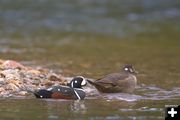

Harlequin Duck
A pair of harlequin ducks rest at a gravel bar in
Grand Teton National Park. Photo by Mark Gocke, WGFD
|
|
G&F seeks Harlequin Duck sightings
by Wyoming Game and Fish
May 26, 2008
The Wyoming Game and Fish Department has expanded survey efforts since 2002 through the federally funded State Wildlife Diversity Grant program in order to more completely document the distribution and number of nesting pairs of Harlequin Ducks in Wyoming. The department is requesting help from the public to collect additional sightings of this colorful duck.
The common name harlequin duck reflects the unusual plumage of the male duck that often astounds first time viewers. White blazes and a white ear spot stand out against a blue-gray back, chestnut colored sides and crown, and a black rump. Although unmistakably bright, this patterning provides excellent camouflage in rushing riffles and bright glare of mountain streams. The light gray female is much drabber compared to her mate. Distinguishing marks include a small white ear spot and light coloration at the base of the bill.
Harlequins nest on remote mountain streams in northwestern Wyoming and winter on the Pacific coast in British Columbia. Ducks nesting in Wyoming comprise the farthest eastern extension of the Pacific coast breeding population. Nothing is known about migration routes or rates, but harlequins begin showing up in Wyoming in early May. Pairs are often seen on rivers and lakes near the mouths of nesting streams early in the season before run-off begins and stream volumes increase.
When the ducks move up into traditional nesting stream segments, males guard their mates closely. When the female has completed laying eggs in mid to late June, the male departs, leaving her the work of incubation and brood rearing. Groups of males are sometimes seen hanging out on mountain lakes in June and July before they fly back to the Pacific coast. Females and young (who are similar in appearance to the female) stay on nesting streams until the young develop flight feathers in late August to mid-September. Adult females will sometimes depart for the coast before their young, so migration routes appear to be genetically determined.
Harlequin ducks are secretive and somewhat sensitive to human presence. Repeated human disturbance to nesting areas has resulted in abandonment of traditional nesting streams in other parts of the western United States. Harlequins will slip away out of sight if disturbed. If pairs or family groups are encountered observers should sit quietly out of sight shielded by vegetation in order to avoid displacing ducks from nesting habitat. Using patience and care, it is possible to watch pairs forage for invertebrates (their main food) in riffles and pools. Ducks will often haul out on banks or gravel bars to rest and preen.
Please report location, date, number and sex of ducks seen to your local Wyoming Game & Fish Department office. Susan Patla, Nongame Biologist in Jackson, is compiling the data records and will be glad to answer any questions concerning the species. She can be reached at susan.patla@wgf.state.wy.us or at (307) 733-2321 ext. 229.
|
